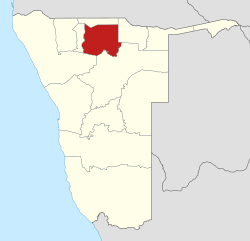Oshikoto Region
Oshikoto is one of the fourteen regions of Namibia, named after Lake Otjikoto[5] near its former capital Tsumeb. The capital of Oshikoto is Omuthiya. The northern part of the region is agricultural, whereas the main economic activities in the southern part are cattle rearing and mining. The two areas have important cultural and historical links in that the Ndonga people have extracted copper at Tsumeb since the earliest times in order to make rings and tools.
Oshikoto Region | |
|---|---|
 Location of the Oshikoto Region in Namibia | |
| Country | Namibia |
| Capital | Tsumeb (-2008), Omuthiya (2008-present) |
| Government | |
| • Governor | Penda Ya Ndakolo[1] |
| Area | |
| • Total | 38,685 km2 (14,936 sq mi) |
| Population (2011)[3] | |
| • Total | 181,973 |
| • Density | 4.7/km2 (12/sq mi) |
| Time zone | South African Standard Time: UTC+2 |
| HDI (2017) | 0.636[4] medium · 7th |
Oshikoto is one of only three regions without either a shoreline or a foreign border. It borders the following regions:
- Ohangwena - north
- Kavango West - east
- Otjozondjupa - southeast
- Kunene - southwest
- Oshana - west
This region comprises eleven constituencies:
Politics
The 2015 local and regional elections saw SWAPO win uncontested nine of the eleven Oshikoto constituencies.[6] The remaining two constituencies SWAPO won by a landslide, with results well over 80%.[7]
Governors
- Penda Ya Ndakolo (2004–2015[8] and 2020–present)[1]
- Henock Kankoshi (2015–2020)[9]
Economy and infrastructure
Pearl millet (Mahangu) is the principal crop in the north, while cattle are reared in the Mangetti and the Tsumeb district. Although the Tsumeb mine has only a limited life span, it can together with the associated support industries and services, provide a boost for the communal areas of the region.
Communication is good in much of the area: a paved trunk road runs across the region, linking it to both the south and the north of the country. The national microwave network terminates at Tsumeb, but telecommunications are now carried across the region and as far as Oshakati by means of a newly laid optical fiber cable.
According to the 2012 Namibia Labour Force Survey, unemployment in the Oshikoto Region is 26.4%.[10] Oshikoto has 200 schools with a total of 60,439 pupils.[11]
Demographics
The region's population has grown significantly over recent years, partly as a result of redistribution within the Oshiwambo-speaking area. Apart from Tsumeb and Oniipa, people have settled in a corridor along the trunk road, sometimes forming quite dense concentrations.
References
- "Goodbye". Namibian Sun. 10 April 2020. p. 1.
- "Namibia's Population by Region". Election Watch. Institute for Public Policy Research (1): 3. 2013.
- "Oshikoto 2011 Census Regional Profile" (PDF). Statistics Namibia. Retrieved 10 April 2020.
- "Sub-national HDI - Area Database - Global Data Lab". hdi.globaldatalab.org. Retrieved 2018-09-13.
- Heita, Desie (13 November 2015). "Oshikoto scores big in development budget". New Era.
- Kangootui, Nomhle (23 October 2015). "Swapo gets ǃNamiǂNûs uncontested". The Namibian. Archived from the original on October 24, 2015.
- "Regional Council Election Results 2015". Electoral Commission of Namibia. 3 December 2015. p. 19. Archived from the original on 8 December 2015.
- Nawatiseb, Engel. "Oshikoto governor creates awareness". New Era. Retrieved 27 January 2014.
- "President announces governors". The Namibian. 10 April 2015. Archived from the original on 14 April 2015. Retrieved 14 April 2015.
- Duddy, Jo Maré (11 April 2013). "Unemployment rate still alarmingly high". The Namibian. Archived from the original on 14 April 2013.
- Miyanicwe, Clemans; Kahiurika, Ndanki (27 November 2013). "School counsellors overstretched". The Namibian. p. 1.
External links
| Wikivoyage has a travel guide for Four-O region. |